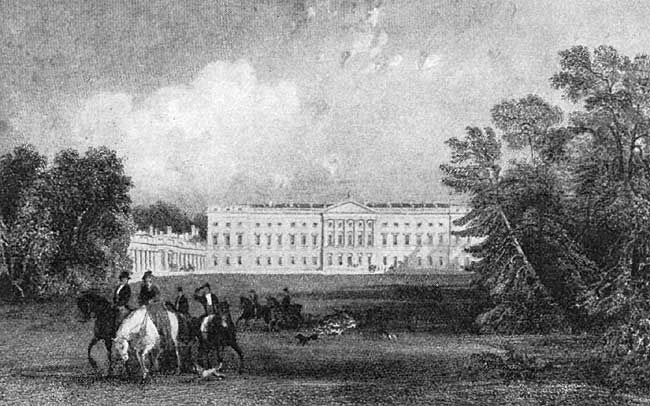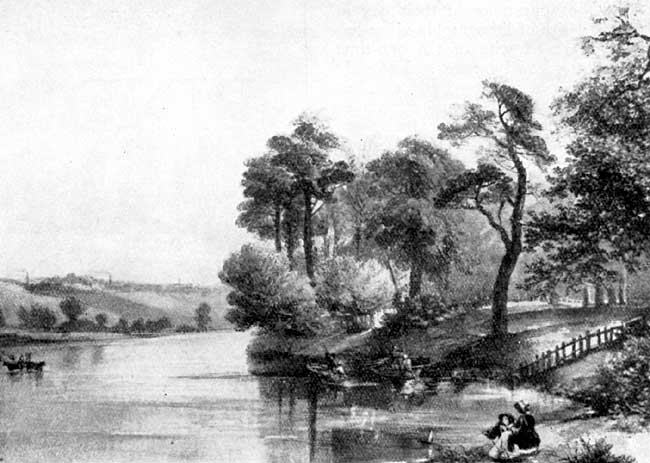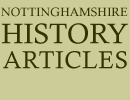
Worksop Manor, by Thomas Allom.
"Newark Church" with its coaching interest provided one of our illustrations last month. In "Newark Castle" the old fortress combines with the trestle bridge and barges to form a lively and pleasing composition. "Southwell Choir" serves as a record both of the interior of the Minster and of Allom's ability as an architectural draughtsman, and for such pleasing records as those I have indicated we are duly thankful.
John Preston Neale (1771-1847) was another eminent Architectural designer and engraver whose name appears beneath some Nottinghamshire views. Like another and yet more famous water-colourist, John Sell Cotman, Neale's interests were in large measure antiquarian and he produced and published a large number of drawings of fonts, screens, memorials and other details from the parochial churches of Great Britain. Several of our county churches were depicted by him.
"The beauties of England and Wales or Deliniations Topographical, Historial and Descriptive, embellished with engravings" contains many plates after his works. The title page of the Nottinghamshire volume shows a view of Nottingham Castle in which a fair amount of artistic licence has been taken, the ancient fishpond, which once reflected the towering rock, is made to appear an extensive lake whereon a sailing boat glides.
His other Nottingham view depicts the town from the north and is taken from the Mansfield Road, nearby present-day St. Andrew's Church. Very pleasant it looks with its windmill and churches, its groups of houses partly masked by smoke, and a tilt-covered wagon on the crown of the hill whence the wide grass-verged road runs down to the town. But the spot where the artist sat to make his drawing had a sinister reputation, it was associated with public hangings and haunted by highwaymen and footpads, in spite of the gallows with their gruesome exhibits which were supposedly a deterrent object lesson to these night-birds. The old caves in the adjacent hollow (now included in the general cemetery, but then screened by gorse and ling) gave shelter and hiding to those who pursued their nefarious operations under cover of dark.
Neale was fond of drawing with a pen and finishing with washes of colour, but his plates have not the charm of Tom Allom's views.
He was not so fortunate in the men who interpreted his work, if we are to judge by the prints such as "Wollaton Hall from the banks of the Trent." Either he was mistaken in the stream or thought little of the "Smug and Silver" river hereabouts. Cattle make it look like a mere ditch, though two sailing boats do their best to restore the balance of proportion.

The Trent at Wilford, by Mrs. William Enfield.
"Colwick Hall," "Newstead Abbey" and "A Saxon Arch leading to Southwell Church" all belong to this series, but the inscription below the last named suggests that Neale did not always work from first-hand sketches, for this is "engraved by H. Hobson from a drawing by J. P. Neale after a sketch by J. Barlow, Esq." Nor is this the only case in "the Beauties" where the practice is evident. "Radford Gate" (at Worksop), showing the gate house with the cross-shaft on its pile of steps in the foreground, is "engraved by W. Woolnoth from a drawing by J. C. Smith after a sketch by W. Shepherd."
Thomas Barber was responsible for the "North View of Staunton Hall," while the "Newark Castle and Bridge" bears the name of E. Goodwin and a date, July 1802, some ten years earlier than the majority of the subjects.
The grey pile of Newark's stronghold, its forbidding river front relieved by the smiling oriel window of Bishop Scot, has long been a favourite subject with artists, and the old castle must have been depicted under every conceivable effect of sunshine and shadow. One of the largest and "liveliest" renderings is a colour aquatint engraved by J. R. Hamble and published by J. Deeley at 95 Berwick Street, Soho, in 1812. In this view the old lamp standards which crowned the bridge appear like obelisks.
Newark has long been a mecca for artists, for its old yards and buildings have been better preserved than is the case in the other towns of the Shire. William Dickinson's admirable history of the borough (1816) contains several illustrations by W. P. Sherlock which, though not remarkable for any artistic qualities, have done a good deal to supplement the historian's work. Perhaps the most successful of these, in so far as it captures something of the spirit of the place, is the North-East View of the Church, made in 1801 and engraved by S. Sparrow.
It is interesting to note that the North and East Gateways of the town, illustrated in this volume, bear the name of J. Pocklington, Esq., who had plates made by Walker from drawings he did of his houses at Muskham and in the North, both of which are quite good work for an amateur of that period.
The plates with which John Throsby illustrated his History of the County (1797) suggest that he, too, was something of an artist as well as historian, "Kirk-lington Hall" and "Strelley" suggesting a vague resemblance to Paul Sandby. The majority of the illustrations, however, are somewhat unsophisticated statements.
Unlike their neighbours of Newark, Nottingham folk have to rely much more generally upon pictorial records to appreciate the appearance of their city in times past. Hence the series of lithographic views left by Mrs. Enfield, the talented wife of the one-time Town Clerk, are highly prized by many. Not only did this good lady use her pencil to good purpose, but her pen, too, has left many interesting accounts of scenes she witnessed. Quite a seasonable atmosphere is attached to her description of "The Great Snowstorm of Christmas Day, 1836." " In that year Christmas Day was on a Sunday; the snow had been falling since Wednesday night almost without intermission; the roads in country districts were impassable, so that on Christmas Eve the different parishes sent out poor men by scores to open them. It is an ill-wind that blows nobody any good; the families of these men rejoiced in that snowstorm because of the excellent wages these shovellers received at a season when employment was scarce. If the storm was severe in the Midlands, the records tell us how much worse it was in the South of London, where high ridges ran across the streets up to the first floor windows; for three days not a shop was opened; and intercourse between London and the South Coast was suspended for that period. .... On awakening that Christmas morn I gazed on the whitest of worlds; the snow was more than a yard thick for it was up to the window sills; the horses were snowed up in the stables; silence reigned impressively over the deserted streets; and the church bells themselves found no tongue to salute the happy morn. As the snow was still falling the ridges deepened and so did the difficulty of getting to the animals. After hours of shovelling on the part of two or three of the household the stable at last became accessible."
Colour lithography gave yet another fillip to the demand for local views, men like C. MacArthur and T. C. Moore finding employment in producing suitable material. But quality fell, and photography drove draughtsmen from the field. For many years the loss thus suffered was not appreciated. Now, happily, talented artists are again concerning themselves with Topographical work—plates like the fine North View of St. Mary's Church, Nottingham, by F. L. Griggs, A.R.A., impress by their dignified manner and accomplished technique; younger men, such as Loxton Knight, are giving us colourful woodcuts of scenes and places we love. Thus, the true spirit of the old recorder-artists is being carried on for the joy of our own and future generations.
